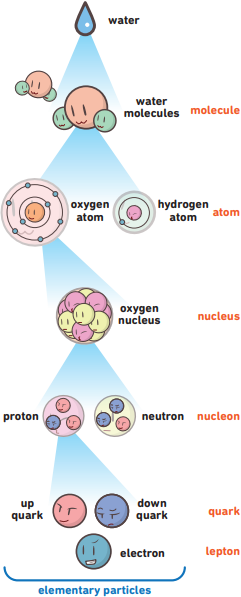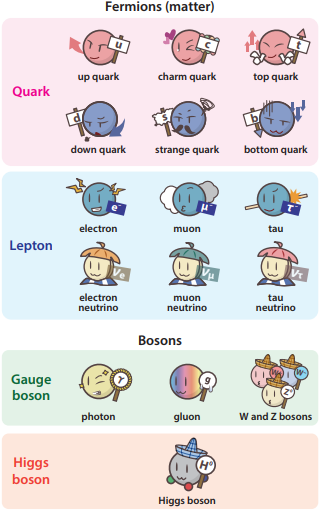What are the neutrinos?
Neutrino means “Neutral = no electric charge” and “-ino = small (in Italian)”. They are one of the elementary particles.

Then, what are elementary particles?
 Elementary particles are the smallest elements that make up matter! Well that doesn’t explain much about them so here we go!
Elementary particles are the smallest elements that make up matter! Well that doesn’t explain much about them so here we go!
For example, water is a bunch of water molecules, and each water molecule is made with two hydrogen atoms and one oxygen atom.
Inside of an atom, electrons are orbiting around a nucleus sitting in the middle.
Further inside of a nucleus, there are protons and neutrons. These two types of particles are called nucleons (A hydrogen nucleus is made up of one proton only).
Then, what about the inside of nucleons? Nucleons are made with three quarks.
There are no smaller particles than these quarks and electrons, the elementary particles. At this moment, we think we cannot further break down these particles.
 The elementary particles include; six types of quarks, six types of leptons (including electrons), gauge bosons which carry forces between particles, and Higgs bosons which give a mass (weight) to other particles. Neutrinos are a type of lepton.
The elementary particles include; six types of quarks, six types of leptons (including electrons), gauge bosons which carry forces between particles, and Higgs bosons which give a mass (weight) to other particles. Neutrinos are a type of lepton.
Furthermore, all these particles have partners called anti-particles which have opposite electric charges. Quarks bind to other quarks strongly and they make up nucleons. On the other hand, leptons bind weakly and they stay alone. Water, flowers, the universe, and even ourselves, everything around us is made by these elementary particles.

In 1930, a scientist named Dr. Pauli found a problem while he was studying neutrons. Pauli thought the problem could be solved by the existence of very light particles without electric charges. However, such a small light particle can pass through any object and Pauli thought it would be impossible to find such a ghost particle. Three years later, Dr. Fermi, who had studied these ghost particles, named these particles neutrinos.
In 1956, two more scientists, Dr. Reines and Dr. Cowan, finally succeeded the first saw neutrinos with an experiment that used a nuclear reactor. Dr. Reines won the Nobel Prize in Physics for this achievement.

 These are so many!
These are so many!
There are so many neutrinos around us. Lots of neutrinos are produced by the Sun during the production of heat, by the supernova explosion at the end of the life of a star, and by nuclear reactors. About 100 trillion neutrinos are passing through our bodies every second, but we cannot feel them and they can't hurt us.
 Invisible ghost particle.
Invisible ghost particle.
Neutrinos are neutral particles without either a positive or negative electric charge. This means neutrinos do not attract, repel, or affect any materials. Furthermore, they are extremely small and they can pass through any atoms. Neutrinos can pass through our bodies and the Earth. Scientists have a hard time to see them because these particles are like ghosts - they even pass through detectors!
 They have mass!
They have mass!
For a long time, people believed neutrinos do not have mass. However, the Super-Kamiokande experiment led by Dr. Kajita and the SNO experiment led by Dr. McDonald overturned this myth. These experiments confirm neutrinos have mass by measuring neutrino oscillations, the phenomena through which 1 type of neutrino can change to another type. The laws of elementary particles, the “Standard Model”, say that neutrinos are massless, but they are not! This discovery was a breakthrough in particle physics!

Neutrinos are the second most abundant particles in the universe only after light. By studying their properties scientists think it may be possible to understand the mystery of the beginning of the universe and the origin of matter. Although neutrinos are extremely important to understand the universe, neutrinos have many mysterious features.

Scientists from different fields of science are collaborating to study neutrinos, including the world’s first study using neutrinos to understand the “difference between matter and antimatter”, and observation of neutrinos from the universe to uncover the mystery of the origin of the universe, such as “why do we exist?”
![]() We perform a high-precision measurement of neutrino oscillations using a neutrino beam produced by the world-class accelerator J-PARC at Tokai-village, Ibaraki prefecture and the Super-Kamiokande detector located at Hida-city, Gifu prefecture, Japan.(T2K experiment)
We perform a high-precision measurement of neutrino oscillations using a neutrino beam produced by the world-class accelerator J-PARC at Tokai-village, Ibaraki prefecture and the Super-Kamiokande detector located at Hida-city, Gifu prefecture, Japan.(T2K experiment)
![]() Neutrino oscillations can be studied by measuring neutrinos from nuclear reactors (Double-Chooz experiment). Furthermore, we aim to establish the technology to monitor nuclear reactors by applying this technology.
Neutrino oscillations can be studied by measuring neutrinos from nuclear reactors (Double-Chooz experiment). Furthermore, we aim to establish the technology to monitor nuclear reactors by applying this technology.
![]() We observe neutrinos from the atmosphere. On top of measurements by the Super-Kamiokande experiment, we are developing the next generation neutrino detector "Hyper-Kamiokande".
We observe neutrinos from the atmosphere. On top of measurements by the Super-Kamiokande experiment, we are developing the next generation neutrino detector "Hyper-Kamiokande".
![]() We observe neutrinos from the universe. These neutrinos carry information from the deep-universe nobody has ever seen (IceCube Neutrino Observatory).
We observe neutrinos from the universe. These neutrinos carry information from the deep-universe nobody has ever seen (IceCube Neutrino Observatory).
![]() We are developing state-of-the-art particle detectors. They improve the nuclear reactor safeguard system, nuclear-imaging technology, and new various other applications.
We are developing state-of-the-art particle detectors. They improve the nuclear reactor safeguard system, nuclear-imaging technology, and new various other applications.
![]() Theoretical studies of neutrinos across particle physics, nuclear physics, and cosmology are important to answer fundamental questions such as “what is spacetime?”.
Theoretical studies of neutrinos across particle physics, nuclear physics, and cosmology are important to answer fundamental questions such as “what is spacetime?”.